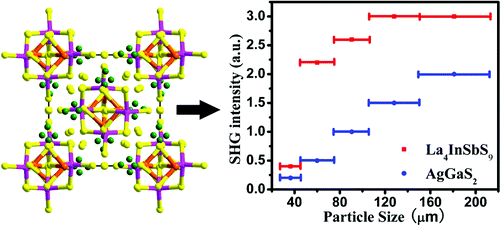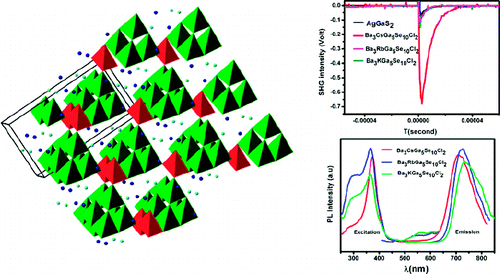Middle-IR (2-20 μm) nonlinear optical (NLO) materials are very important in laser technology, such as atmospheric sensing and communications. The typical IR benchmark materials AgGaS2 and ZnGeP2 suffer several drawbacks, such as a low laser damage threshold and the two-photon absorption. Therefore, the exploration of new IR NLO materials is of broad interest and great challenge.
A research team led by Prof. CHEN Ling at Fujian Institute of Research on the Structure of Matter (FJIRSM), Chinese Academy of Sciences, has recently made several breakthroughs in the rational design and synthesis of IR NLO material. They have discovered a novel chiral La4InSbS9 showing the strongest Kleinman-forbidden second harmonic generation (SHG) to date with an intensity of 1.50 times benchmark AgGaS2 at 2.05 um laser in type I phase-matchable behavior. (J. Am. Chem. Soc.,134,2012,1993–1995.). It is well known that the presence of dispersion can lead to the Kleinman-forbidden SHG,especially when the second harmonic frequency is close to an absorption band gap of the material, the electronic exciton resonance would be expected which can significantly enhance the SHG effect. But, this is not the case for La4InSbS9 under their measurement condition. Further DFT calculations and ab initio molecular dynamic simulations suggest the lattice vibrations may be responsible for the origin and magnitude of the strong SHG effect from La4InSbS9. Their further exploration has led to the first inorganic open-framework chalcohalide Ba3CsGa5Se10Cl2 exhibiting the strongest SHG effect with intensity 100 times that of the benchmark AgGaS2 in the particle size of 30−46 μm among chalcogenides, halides, and chalcohalides. (J. Am. Chem. Soc.,134,2012,2227–2235. ). These results may shed useful light on the exploration of new materials with the excellent IR NLO performance.

Figure 1. La4InSbS9 shows the strongest Kleinman-forbidden SHG to date.(Image by CHEN Ling’s Group)

Figure 2. Powder Ba3CsGa5Se10Cl2 exhibits the strongest SHG with intensity 100 times that of the benchmark AgGaS2 in the particle size of 30−46 μm.(Image by CHEN Ling’s Group)
Besides, Prof. CHEN’s group has obtained a series of potential IR NLO crystalline materials recently, such as Ln4GaSbS9 (Ln = Pr, Nd, Sm, Gd–Ho) (J. Am. Chem. Soc.,2011,133, 4617–4624.), Pb2B5O9I(J. Am.Chem. Soc.,2010,132, 12788–12789. ), and La2Ga2GeS8, Eu2Ga2GeS7(Inorg.Chem.,2011,50, 12402–12404. ).
Contact:
Prof. CHEN Ling
Fujian Institute of Research on the Structure of Matter
Chinese Academy of Sciences
Email: chenl@fjirsm.ac.cn